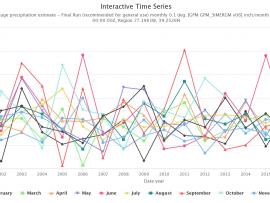Browse Remote Sensing Resources
Browse Remote Sensing Resources
Primary Topic:
Subtopics:
Type:
Summary:
In this article from the summer 2024 edition of The Earth Scientist, learn about NASA's Global Precipitation Measurement mission and the many tools and resources it offers for understanding Earth's water cycle and weather.
Primary Topic:
Subtopics:
Type:
Summary:
Using the My NASA Data Literacy Cubes will enhance students exploration of graphs, maps, and datasets to enrich their observations and inferences. The cubes offer an interactive and engaging way for participants to explore graphs, maps, and datasets.
Primary Topic:
Subtopics:
Type:
Summary:
Students will use various visualizations (i.e. images, charts, and graphs) to explore the energy exchange that occurs when hurricanes extract heat energy from the ocean.
Primary Topic:
Subtopics:
Type:
Summary:
In this lesson, students will learn how to compare data displays related to tropical cyclones to identify patterns and relationships in the data. They will be able to create their own data displays or use the ones provided.
Primary Topic:
Subtopics:
Type:
Summary:
Learn all about hurricanes, the most violent storms on Earth.
Primary Topic:
Subtopics:
Type:
Keywords:
Summary:
Did you know NASA has satellites that observe rain and snow all over the world? With this activity you can access NASA data to see how much precipitation was observed by satellites for your location any time from June 2000 to the present.
Primary Topic:
Subtopics:
Type:
Summary:
Use this iQuest to find out about predictions for the 2019 hurricane season and discover how hurricanes form. You will also learn how NASA satellite data is being used to help predict, monitor, and respond to these deadly storms.
Primary Topic:
Subtopics:
Type:
Standards:
Keywords:
Summary:
Step by step instructions and a parts list to build your own LEGO model of GPM precipitation data collected from Hurricane Irma on 9/5/17.
Primary Topic:
Subtopics:
Type:
Summary:
For the first time in 360 degrees, this data visualization takes you inside a hurricane. The precipitation satellite has an advanced radar that measures both liquid and frozen water. Click and drag to look around.
Primary Topic:
Subtopics:
Type:
Standards:
Summary:
This web eBook, developed in collaboration with the World Bank Group, explores water on Earth and how NASA observes and measures it.











